Institutional repositories
- 1. Institutional Repositories Tor Loney, Information Literacy librarian University at Albany Libraries
- 2. DEFINITIONS MIT Libraries: •Database with a set of services to capture, store, index, preserve and redistribute a university’s scholarly research in digital formats Open Access and Institutional Repositories
- 3. DEFINITION Clifford Lynch: •Set of services that a university offers to the members of its community for the management and dissemination of digital materials created by the institution and its community members Open Access and Institutional Repositories
- 4. EVOLUTION Raym Crow: •Digital collections capturing and preserving the intellectual output of a single or multiple-university community SPARC: •Institutionally defined, Scholarly, Cumulative and perpetual, Open and interoperable Open Access and Institutional Repositories
- 5. EARLY EXAMPLES •Founded 1991 •Online 1999 Open Access and Institutional Repositories
- 6. CURRENT EXAMPLES Open Access and Institutional Repositories
- 7. SOFTWARE BRICKS Closed-Source, Fee-Based: Open Access and Institutional Repositories
- 8. ADVANTAGES Institution: • Exposure • Cachet • Collaboration • Support and retention • Cost reduction Open Access and Institutional Repositories
- 9. ADVANTAGES Open Access provides higher citation rates Open Access and Institutional Repositories
- 10. ADVANTAGES Author: • Exposure • Speed • Access • Multiformat • Collaboration Open Access and Institutional Repositories
- 11. ADVANTAGES Community: • Exposure • Speed • Collaboration • Access Open Access and Institutional Repositories
- 12. ADVANTAGES Community: • Shouldn’t we have access to research our tax dollars paid for? Open Access and Institutional Repositories
- 13. OBSTACLES Over All: • Lack of awareness Open Access and Institutional Repositories
- 14. OBSTACLES Institution: • Startup costs • Maintenance fears • Lack of models/policies • Lack of awareness Open Access and Institutional Repositories
- 15. OBSTACLES Author: •“No time” •Tenure requirements •View IRs as non-scholarly •Technophobia Open Access and Institutional Repositories
- 16. SUGGESTIONS Institution: • Demonstrate value • Develop repository and policy simultaneously • Tailor to specific needs • Gain campus support Open Access and Institutional Repositories
- 17. SUGGESTIONS Author: •Demonstrate value •Address fears •Make voluntary •Provide clear definitions •Provide full service Open Access and Institutional Repositories
- 18. SUGGESTIONS Community: • Ongoing promotion • Extend to students • Host community content • Include other collections • Cross-fertilization Open Access and Institutional Repositories
- 19. SUGGESTIONS Tell Everyone! Open Access and Institutional Repositories
- 20. FURTHER READING • Albanese, A. (2009). Institutional Repositories: Thinking beyond the box. Library Journal, 134(4), 26-28. • Crow, R (2002). The case for institutional repositories: A SPARC position paper. ARL, 223(August 2002), 1-4. • Davis, P. M., & Connolly, M. L. (2007). Evaluating the reasons for non-use of Cornell University's installation of DSpace. D-Lib Magazine, 13(3), doi:10.1045/march2007-davis • Drake, M. (2004). Institutional repositories: Hidden treasures. Searcher, 12(5), 41-45. • Lynch, C. (2003). Institutional repositories: Essential infrastructure for scholarship in the digital Age. ARL, 226(February 2003). 1-7. • Poynder, R. (2006). Clear blue water [Web log post]. Retrieved October 17, 2012, from http://ia700201.us.archive.org/13/items/The_Basement_Interviews/BlueWaterMain.pdf • SPARC Institutional Repository Checklist & Resource Guide • Swan, A. (2010). The open access citation advantage: Studies and results to date. Technical Report, School of Electronics and Computer Science, University of Southampton, Southampton. Retrieved from http://eprints.ecs.soton.ac.uk/18516/2/Citation_advantage_paper.pdf • Xu, L., Liu, J. & Fang, Q. (2011). Analysis on open access citation advantage: An empirical study based on Oxford open journals. Proceedings of the 2011 iConference, February 11, 2011, Seattle. Retrieved from http://delivery.acm.org/10.1145/1950000/1940819/p426- xu.pdf?ip=169.226.84.8&acc=ACTIVE%20SERVICE&CFID=130923915&CFTOKEN=9886942 1&__acm__=1350923458_008c17ac398aa3046147e77d3aad516e Open Access and Institutional Repositories
- 21. CONTACT Tor Loney tloney@albany.edu • I am an Information Literacy librarian and instructor at the University at Albany, and am also currently engaged in a SUNY Innovative Instruction Technology Grant on the creation of an online information literacy tool. Interests • Information Literacy, Emerging Technology, Copyright, Open Access, and Collaboration Professional Association Involvement • ACRL Technology in University Libraries Section • NYLA Section on Management of Information Resources and Technology • University at Albany Libraries Emerging Technologies Committee Open Access and Institutional Repositories
Editor's Notes
- #3: Definition by MIT Libraries, who created DSPACE – one of the first and still most-used software applications for institutional repositories.This definition focuses primarily on the archiving and preservation aspects.
- #4: Clifford Lynch, head of Coalition for Networked Information, highlights the service component.He adds: It is most essentially an organizational commitment to the stewardship of these digital materials, including long-term preservation where appropriate, as well as organization and access or distribution.
- #5: In a 2002 paper titled The Case for Institutional Repositories, Crow created what has become the standard definitionSPARC, the Scholarly Publishing and Academic Resources Coalition adopted this , and has since widened it to highlight elements such as free access and interoperability
- #6: arXiv, started at the Los Alamos National Laboratory in New Mexico, and now housed at Cornell, is generally considered to be the first academic institutional repositoryOther notable early repositories include the arXiv extension Cogprints, the Networked Computer Science Technical Reports Library, several NASA databases, and RePec, a consortial economics repository.Each of these was centralized rather than local to an institution, and all of these, and most other early repositories were subject-specific – and generally science-related(all of these still exist, and have expanded beyond their initial institutional boundaries)
- #7: Notable current examples include:Early adopter’s MIT and University of CaliforniaUniversity of Wisconsin’s Deep BlueUniversity of Wisconsin’s Minds at UWRochester Institute of Technology’s Digital Media LibraryGeorgia Tech’s Smart Tech
- #8: For early repositories, software was often developed. Some examples of this and newer applications include:D-Space: created by MITFedora: created at Cornell (these two merged to form Duraspace)ePrints: University of Southampton School of Electronics and Computer Science, EnglandRefbase: University of Kiel in GermanyBRICKS: “Building Resources for Integrated Cultural Knowledge Services,” created by consortia of European schools and businessesGreenstone: University of Waikato, NZInvenio: European Organization for Nuclear Research (CERN)Omeka: created by George Mason UniversityContent dm: created at U Washington, now owned by OCLCDigital Commons: created and run by Berkeley Electronic Press (Bepress)
- #9: Avenue of promotion and increased visibilityThe repository itself and the work within it demonstrate a commitment to scholarly workAllows for collaboration across departments, campuses, and with the wider communityAvenue to support research by faculty and students, and encourage local investment and engagementDon’t have to pay for their own articles.Potentially, future savings due to decrease of fee-based journals
- #10: The “Open Access Citation Advantage”A 2011 study comparing of articles published in both formats within one journal found nearly 40% higher citation rates for OAA 2010 survey conducted in various disciplines found that 87% reported higher citation rates for articles published in Open Access
- #11: Avenue of promotion and increased visibilityEliminate gap between submission and publication, as well as common online embargosGenerally, authors retain rights and full access, and are free to republish elsewhereMultiple mediums can be submitted, as well as multiple document types – including raw dataAllow for collaboration across departments, campuses, and with the wider community
- #12: Community, meaning both on-campus and beyond:Community members are able to see what each other are doingThis increases the speed of research. Richard Johnson, former executive director of SPARC stated: “The ability to locate and retrieve more relevant research more quickly and easily online will improve scholarly communication and advance scholarly research”This also allows for collaboration, most notably across disciplines and between unexpected partnersAnd they provide access by the wider community
- #13: Many, including the Scholarly Publishing and Academic Resources Coalition and the New York State Higher Education Initiative, are lobbying for open access to research done at public institutionsThe “taxpayer access to publically funded research act” (TAPFR) is currently active in the New York State LegislatureThere are federal models for this: the federal research public access act, Obama’s Memorandum on Transparency and Open Government, and others
- #14: The SUNY system does have a repository, which has existed since 2005It currently houses 19 University at Albany items, all of which were posted by two faculty members in the same department
- #15: There is often a fear of cost, both financial and relating to time required for creation of an IRThis extends to maintenance concerns, which also include financial and time expendituresCurrent policies do not easily fit with the idea of an IR, and there are few well-known examplesMost institutions are unaware of either the need or value of IRs
- #16: Most academic researchers feel they have no time to spare on formatting and submitting articlesOpen Access journals don’t meet most institutions’ tenure requirements, causing fearful associations that extend to IRsSome view IRs as non-scholarly areas that lessen the esteem of their workSome fear the technical elements involved, ranging from digitization and formatting, creating metadata, submitting, and future access
- #17: Benefits should be explained in detail, first to administration and then to the wider communityInstitutions should develop policy alongside a new repository, so the two complement each otherFollowing SPARC’s idea of institutional definition, an IR should be designed around local needs and collectionsPartner with invested members, such as campus centers for research, copyright centers and Interlibrary loan offices
- #18: Many are unaware of the benefits of repositories (and open access) – educate them! This includes explaining the citation advantage, and the fact that IRs offer opportunities for advanced citation indexing.Further, for teaching faculty IRs provide spaces to share teaching materials in a greatly expanded wayExplain that there will be no loss of rights, and that submission is optionalDifferentiate between submission types such as preprints and peer-reviewed articlesScan and upload articles for faculty –self-submission is the most-cited obstacle to the success of IRs
- #19: Promote the IR, before, during, and after its implementationAdd student papers, theses and dissertationsReach out to local journals (includingstudent newspapers, departmental newsletters, etc.)Fold in already existing local collectionsUse as an opportunity to foster collaboration and sharing, both on campus and beyond

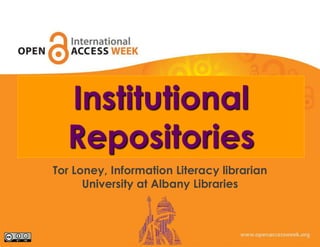
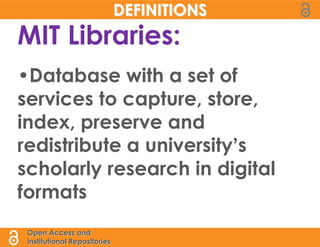
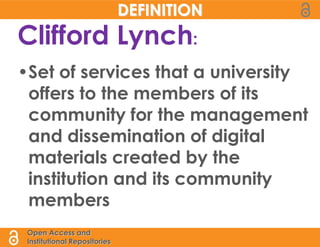
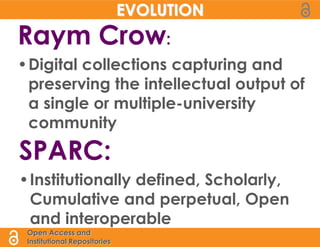
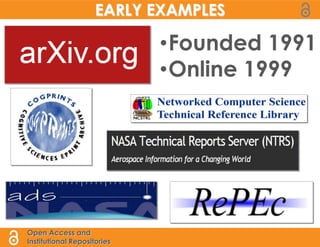


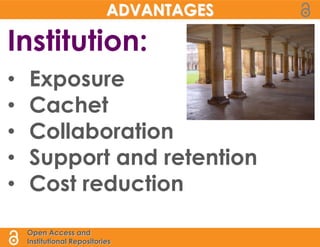
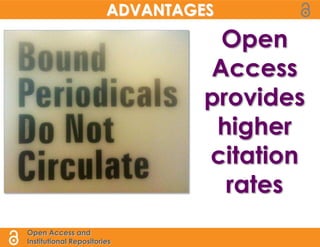


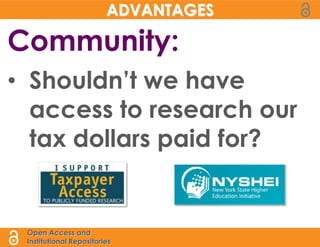
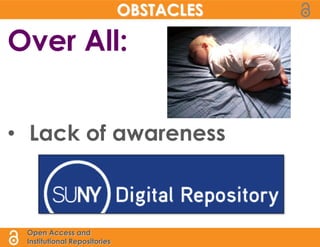
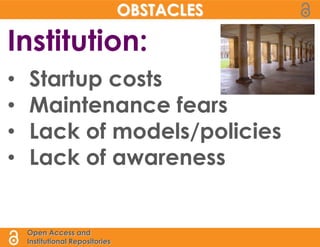

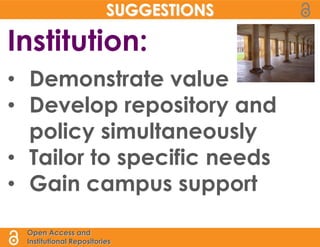



![FURTHER READING
• Albanese, A. (2009). Institutional Repositories: Thinking beyond the box. Library Journal,
134(4), 26-28.
• Crow, R (2002). The case for institutional repositories: A SPARC position paper. ARL,
223(August 2002), 1-4.
• Davis, P. M., & Connolly, M. L. (2007). Evaluating the reasons for non-use of Cornell
University's installation of DSpace. D-Lib Magazine, 13(3), doi:10.1045/march2007-davis
• Drake, M. (2004). Institutional repositories: Hidden treasures. Searcher, 12(5), 41-45.
• Lynch, C. (2003). Institutional repositories: Essential infrastructure for scholarship in the
digital Age. ARL, 226(February 2003). 1-7.
• Poynder, R. (2006). Clear blue water [Web log post]. Retrieved October 17, 2012, from
http://ia700201.us.archive.org/13/items/The_Basement_Interviews/BlueWaterMain.pdf
• SPARC Institutional Repository Checklist & Resource Guide
• Swan, A. (2010). The open access citation advantage: Studies and results to date.
Technical Report, School of Electronics and Computer Science, University of
Southampton, Southampton. Retrieved from
http://eprints.ecs.soton.ac.uk/18516/2/Citation_advantage_paper.pdf
• Xu, L., Liu, J. & Fang, Q. (2011). Analysis on open access citation advantage: An
empirical study based on Oxford open journals. Proceedings of the 2011 iConference,
February 11, 2011, Seattle. Retrieved from
http://delivery.acm.org/10.1145/1950000/1940819/p426-
xu.pdf?ip=169.226.84.8&acc=ACTIVE%20SERVICE&CFID=130923915&CFTOKEN=9886942
1&__acm__=1350923458_008c17ac398aa3046147e77d3aad516e
Open Access and
Institutional Repositories](https://image.slidesharecdn.com/institutionalrepositories-121023085421-phpapp02/85/Institutional-repositories-20-320.jpg)
